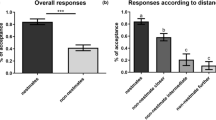Abstract
Differences were found in the pheromonally mediated mate location systems of two subspecies of Hemileuca electra, H. electra electra (Hee) and H. e. mojavensis (Hem), from southern California. Hem female pheromone gland extracts contained eight times as much (10E,12Z)-hexadeca-10,12-dienal (E10,Z12–16:Ald) and half as much hexadecyl acetate (16:Ac) as Hee extracts. Relative amounts of the other major component of the pheromone blends, (10E,12Z)-hexadeca-10,12-dien-1-ol (E10,Z12–16:OH) did not differ between the two subspecies. In coupled gas chromatography–electroantennogram studies, responses of male antennae to 1:1:1 mixtures of the three principal components (E10,Z12–16:Ac, E10,Z12–16:OH, E10,Z12–16:Ald) also differed, with Hem antennae producing significantly larger responses to E10,Z12–16:Ald and significantly smaller responses to 10E,12Z–16:Ac than Hee. In field trials, male Hem were attracted to Hem females in preference to Hee females. Males of a second species, H. burnsi, which is sympatric with Hem but not Hee, also were attracted to females of Hee transported to their range. Field tests of blends of synthesized pheromone components confirmed that male Hem preferred E10,Z12–16:Ald ratios of 10–100% of the major component, E10,Z12–16:Ac, whereas males of Hee and H. burnsi responded optimally to ratios of 0.3–1% E10,Z12–16:Ald to E10,Z12–16:Ac. 16:Ac added to lures increased attraction of Hee but not Hem males. The data presented are consistent with reproductive character displacement, whereby the Hem subspecies has modified its pheromone-based mating system to reduce interference from sympatric H. burnsi.
Similar content being viewed by others
REFERENCES
Arn, H., TÖth, M., and Priesner, E. 1995. The Pherolist, Internet edition. http://www.nysaes.cornell.edu/pheronet/
Brown, W. L., Jr., and Wilson, E. O. 1956. Character displacement. Syst. Zool. 5:49-64.
Butlin, R. K. 1987. Speciation by reinforcement. Trends Ecol. Evol. 2:8-13.
Butlin, R. K. 1995. Genetic variation in mating signals and responses, pp. 327-366, in D. M. Lambert and H. G. Spencer (eds.). Speciation and the Recognition Concept: Theory and Application. Johns Hopkins University Press, Baltimore.
CardÉ, R. T., CardÉ, A. M., Hill, A. S., and Roelofs, W. L. 1977. Sex pheromone specificity as a reproductive isolating mechanism among the sibling species Archips argyrospilus and A. mortuanus and other sympatric Tortricine moths (Lepidoptera: Tortricidae). J. Chem. Ecol. 3:71-84.
Dai, X. J., Xu, S. F., Wang, M. Z., and Du, J. W. 1987. Preliminary studies on chemical structure of mulberry white caterpillar, Rondotia menciana Moore, sex pheromone. Shang-hai: Shang-hai koo hsèueh chi shu chou pan she (Contrib. from Shanghai Inst. Entomol.) 7:7-12.
Howard, D. J. 1993. Reinforcement: Origin, dynamics, and fate of an evolutionary hypothesis, pp. 46-69, in R. G. Harrison (ed.). Hybrid Zones and the Evolutionary Process. Oxford University Press, New York.
Humason, G. L. 1972. Animal Tissue Techniques, 3rd. ed. W. H. Freeman & Co. San Francisco.
Klun, J. A., and Cooperators. 1975. Insect sex pheromones: Intraspecific pheromone variability in North America and Europe. Environ. Entomol. 4:891-894.
Linn, C. E., Jr., and Roelofs, W. L. 1995. Pheromone communication in moths and its role in the speciation process, pp. 263-300, in D. M. Lambert and H. G. Spencer (eds.). Speciation and the Recognition Concept. Johns Hopkins University Press, Baltimore.
LÖfstedt, C. 1991. Evolution of moth pheromones, pp. 57-73, in Proceedings, Conference on Insect Chemical Ecology, Tabor. Academic Prague and SPB Acad. Publ., The Hague.
McElfresh, J. S., and Millar, J. G. 1999a. Sex pheromone of the common sheep moth, Hemileuca eglanterina, from the San Gabriel Mountains of California. J. Chem. Ecol. 25:687-709.
McElfresh, J. S., and Millar, J. G. 1999b. Sex pheromone of Nuttall's sheep moth, Hemileuca nuttalli, from the eastern Sierra Nevada Mountains of California. J. Chem. Ecol. 25:711-726.
McElfresh, J. S., and Millar, J. G. 1999c. Sex attractant pheromone of the saturnid moth Coloradia velda. J. Chem. Ecol. 25:1067-1077.
Roelofs, W. L., and Brown, R. L. 1982. Pheromones and evolutionary relationships of Tortricidae. Annu. Rev. Ecol. Syst. 13:395-422.
Roelofs, W. L., Glover, T., Tang, X.-H., Sreng, I., Robbins, P., Eckenrode, C., LÖfstedt, C., Hansson, B. S., and Bengtsson, B. S. 1987. Sex pheromone production and perception in European corn borer moth is determined by both autosomal and sex-linked genes. Proc. Natl. Acad. Sci. U.S.A. 84:7585-7589.
SAS Institute. 1996. SAS System for Personal Computers, Release 6.12. SAS Institute Inc., Cary, North Carolina.
Thomson, D. R., Angerelli, N. P. D., Vincent, C., and Gaunce, A. P. 1991. Evidence for regional differences in the response of oblique-banded leafroller [Choristoneura rosaceana (Lepidoptera: Tortricidae)] to sex pheromone blends. Environ. Entomol. 20:935-938.
TÖth, M., LÖfstedt, C., Blair, B. W., Cabello, T., Farag, A. I., Hansson, B. S., Kovalev, B. G., Maini, S., Nesterov, E. A., Pajor, I., Sazonov, A. P., Shamshev, I. V., Subchev, M., and SzÖcs, G. 1992. Attraction of male turnip moths Agrotis segetum (Lepidoptera: Noctuidae) to sex pheromone components and their mixtures at 11 sites in Europe, Asia, and Africa. J. Chem. Ecol. 18:1337-1347.
Tuskes, P. M. 1984. The biology and distribution of California Hemileucinae (Saturniidae). J. Lepid. Soc. 38:281-309.
Tuskes, P. M., and McElfresh, S. 1995. The biology and distribution of Hemileuca electra (Saturniidae) populations in the United States and Mexico, with descriptions of two new subspecies. J. Lepid. Soc. 49:49-71.
Tuskes, P. M., Tuttle, J. P., and Collins, M. M. 1996. The Wild Silk Moths of North America: A Natural History of the Saturniidae of the United States and Canada. Cornell University Press, Ithaca, New York.
Young, D. C., and Vouros, P. 1990. Gas chromatography-mass spectrometry of conjugated dienes by derivatization with 4-methyl-1,2,4-triazoline-3,5-dione. J. Chromatogr. 522:295-302.
Author information
Authors and Affiliations
Rights and permissions
About this article
Cite this article
McElfresh, J.S., Millar, J.G. Geographic Variation in Sex Pheromone Blend of Hemileuca electra from Southern California. J Chem Ecol 25, 2505–2525 (1999). https://doi.org/10.1023/A:1020826208715
Issue Date:
DOI: https://doi.org/10.1023/A:1020826208715




